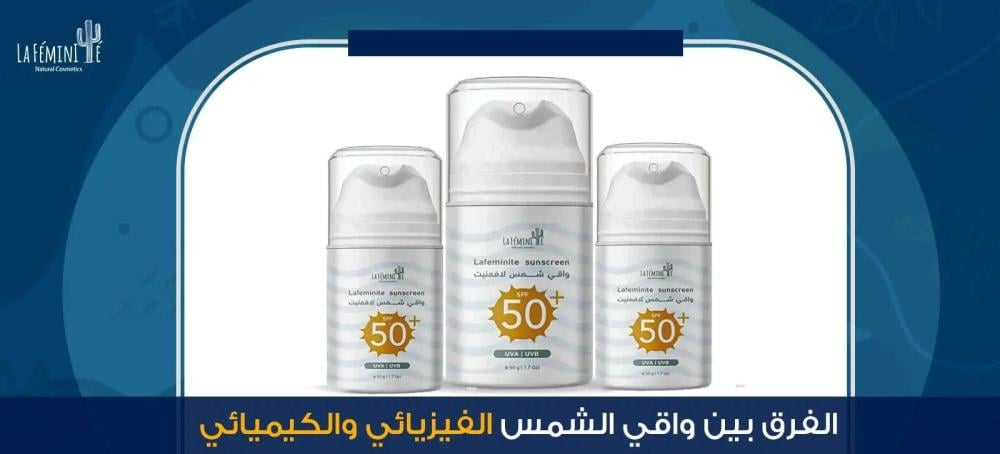Have you ever wondered about the difference between physical and chemical sunscreen? When wanting to buy sunscreens, many women are confused about the difference between them, the advantages and disadvantages of each, and how to use them.
Therefore, in this article, we will learn with you the difference between physical sunscreen and chemical sunscreen, as well as the products available in the Loveminet store to protect against harmful sun rays.
sunscreen definition
Sunscreens (or sunblock) can be defined as topical preparations that are applied to protect the skin and body from the harmful side effects of ultraviolet rays. They also come in two main types: chemical and mineral (or physical) sunscreens, which makes it easy for us to explain the difference between physical and chemical sunscreen in its composition, texture, method of action, and effect on the skin.
Benefits of sunscreens
Sunscreen is an essential part of the daily routine that cannot be dispensed with, as its use is not limited to the summer when temperatures are high, but is also used in all seasons to protect the skin from:
- Wrinkles, premature signs of aging and fine lines.
- It changes its color as it works to unify the skin tone and maintain its original color.
- The appearance of dark spots resulting from aging.
- Possibility of developing skin cancers.
- Burns resulting from prolonged exposure to sunlight.
Different forms of sunscreen
Sunscreen comes in different shapes and forms which can be mentioned as follows:
1- Lotion
The lotion is suitable for people with combination and oily skin, as it is water-based, so it is light in texture and weight, and it is also easy to absorb into the skin.
2- Gel
The gel texture is lighter than the lotion texture and is more suitable for people with oily skin.
3- Cream
Unlike lotion, cream has an oily base and a heavy texture, as it provides dry skin with the high hydration it needs, so the cream is very suitable for people with dry skin.
4- Powder
Powder sunscreen is great for use over makeup after applying it to protect against the sun.
5- Steak
It is easy to apply to the face when you want to replenish your sunscreen.
6- Spray
Spray sunscreen is also easy to use when you want to reapply sunscreen, but you must be careful when applying it to ensure that you completely cover all areas that you want to protect.
Differences between physical and chemical sunscreen
Physical and chemical sunscreens can be compared in several ways, which can be mentioned as follows:
1- Product components
The ingredients in each of them differ, as:
- Physical sunscreen contains inorganic compounds such as titanium dioxide and zinc oxide.
- While chemical sunscreens contain some organic compounds (carbon-containing compounds) such as octinoxate, oxybenzone, homosalate, octocrylene, and avobenzone.
2- Product texture and feel
They can be distinguished by noting the difference in texture and consistency of each, as:
- Physical sunscreen has a heavy texture and is therefore difficult to blend and distribute on the skin, in addition to leaving a white layer on the skin after application.
- Unlike physical sunscreens, chemical sunscreens are light on the skin and quickly absorbed, in addition to not leaving a white layer on the skin after application.
3- How to apply the product
The method of applying physical sunscreen differs from chemical sunscreen, as:
- Physical sunscreen provides immediate sun protection upon application, so there is no need to apply it before sun exposure.
- While chemical sunscreen, in order to provide effective protection for your skin, must be applied about a quarter or half an hour before exposure to sunlight to achieve the desired result.
4- Skin reaction
Each can have a different effect on your skin.
- Physical sunscreen is the most suitable for sensitive skin, as it does not cause any type of allergy or irritation.
- While chemical sunscreen causes noticeable irritation and sensitivity to the skin, especially sensitive skin.
5- The effect of sunscreens on the environment
- Physical sunscreen is safer for the environment, as well as coral reefs and does not cause any harm to them.
- Chemical sunscreen is harmful to coral reefs in the water because it contains oxybenzone, so its use has been banned in many coastal areas such as Palau, the US Virgin Islands, Bonaire and Hawaii.
6- How sunscreens work
When looking at how sunscreen works, we can easily see the difference between physical and chemical sunscreen, as the mechanism of action of each is as follows:
- Physical sunscreens work by forming a barrier and protective layer over the skin when applied, thus scattering and reflecting UV rays as they hit the skin.
- Chemical sunscreens absorb ultraviolet rays when they fall on the skin, then convert these rays into heat and then get rid of them outside the body.
Thus, we have explained to you in some detail the difference between physical and chemical sunscreen so that you can easily identify the nature of your product.
Specifications of a good sunscreen
When you choose a sunscreen, it must have certain specifications in order to provide the necessary protection for your skin from harmful ultraviolet rays, including:
- The sunscreen should not contain any compounds that cause skin sensitivity and irritation. It is best to use physical sunscreens that contain titanium dioxide and zinc oxide.
- SPF starting from 80:50%.
- It is necessary to choose the sunscreen that is suitable for your skin type, as:
Sensitive skin: Use a cream that is completely free of any perfumes to avoid irritation and redness.
Dry skin: Use a cream that contains high levels of moisturizers to protect it from the signs of premature aging and dryness.
Oily skin: Choose a water-based sunscreen so that it does not leave any greasy feel on the skin when applied and then absorbs quickly.
Normal skin: You can choose a normal sunscreen with moderate moisturizing.
- Be careful to choose a sunscreen that matches your skin tone so that it does not appear as just a white layer on your skin.
Best Sunscreen From Loveminet Store
Lavment sunscreen is the best choice to protect your skin from the sun's harmful UV rays, due to the following features:
- Providing a powerful SPF 50+ protection factor that effectively protects your skin from long and medium UV rays.
- It is suitable for all skin types, especially sensitive skin.
- It provides high hydration to the skin and protects it from dryness and signs of premature aging.
- It increases the production of collagen in the skin due to its content of vitamins A and C.
- It soothes redness and itching of the skin due to its anti-inflammatory properties.
Get now the sunscreen from Lavment and enjoy superior protection for your skin before exposure to the sun.
By reaching the end of our article, we have explained to you, dear, in detail the difference between physical and chemical sunscreen, as well as the best sunscreen for the skin from the Lavment store .
So, make sure to use the appropriate sunscreen for your skin before going out, to protect your skin and maintain its freshness and vitality.
Frequently Asked Questions About the Difference Between Physical and Chemical Sunscreen
What is the safest sunscreen?
Physical or mineral sunscreen is safer for your skin as well as the environment.
Is it permissible to mix moisturizer with sunscreen?
It is not recommended to use sunscreen before moisturizing cream, as this can change its properties and thus not protect your skin from the sun's rays, so it is always recommended to apply moisturizing cream before applying sunscreen.
Can sunscreen be diluted with water?
Sunscreens should never be diluted with water, as this reduces the protection factor required for the skin.


